12.1 Soils, Fertility, and Plant Growth
Learning objectives
By the end of this lesson you will be able to:
- Describe how soil texture and soil structure affect plant growth.
- Use simple tests to determine the texture of soil.
- Determine the meaning and impact of the three numbers typically displayed on fertilizer labels.
This is a course about plant propagation, but propagation is only useful if you can successfully grow the plants you propagate. Soil, light, and water are key to growing healthy plants. Here you’ll have a brief introduction to soils and soil fertility — a huge area of knowledge and study.
Watch this video for an explanation of soil texture and soil structure (1:06)
Soil texture
Soil has two key properties: texture and structure. Soil texture refers to the relative proportion of sand, silt, and clay particles in the soil. Sand, silt and clay are the three sizes of mineral particles (originating from rock rather than from previously living material) that make up soil. Sand is the largest particle, silt is intermediate, and clay is very small. In relative terms, if sand is a 55-gallon barrel, silt is the size of a plate, and clay is the size of a dime.
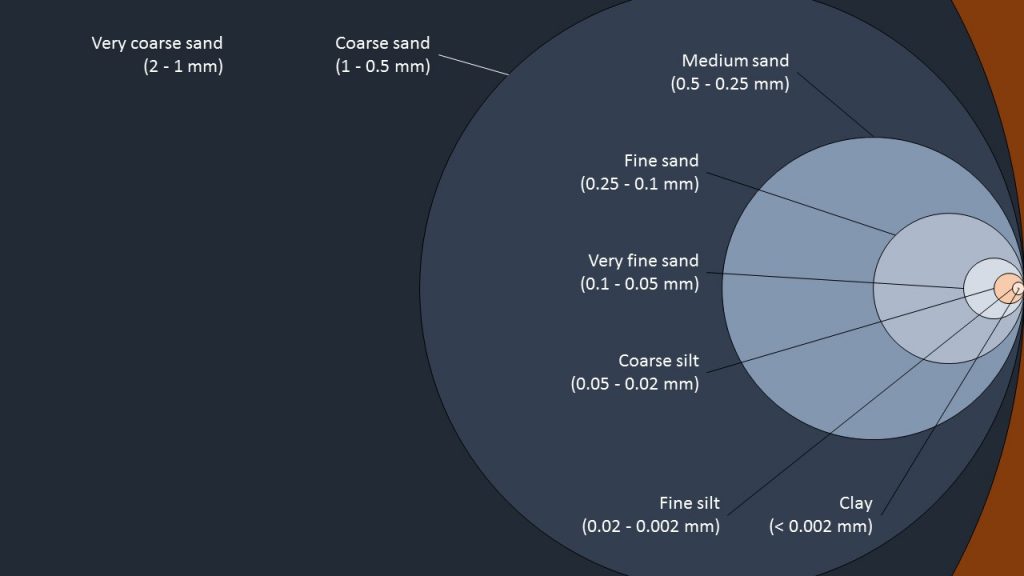
This mixture of different-sized particles is called texture because of how different combinations of these particle types make soil feel when you rub a sample between your thumb and forefinger. High amounts of sand makes a soil sample feel gritty, more silt makes it feel floury, and lots of clay makes it feel like velvet when dry and sticky when wet.
You can get a good idea of the texture of a field soil by doing a simple “jar test:” put soil in a jar, add water, shake the jar, then wait a few days to see the layers of different size particles settle.
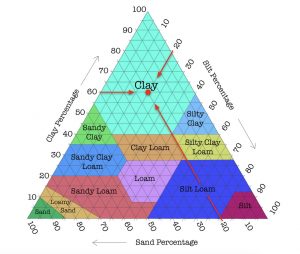
The USDA Soil Texture Triangle, above, indicates the type of soil for different percentages of sand, silt, and clay. Notice that there are lines running through the triangle; these are to help you associate the percentages on the margins of the triangle with locations in the interior. The numbers on the margins are angled so that they are roughly parallel to the associated index lines. For example, the 60% clay index line is a horizontal line extending to the right of the 60 on the percent clay margin. The 20% silt index line runs from the upper right to the lower left of the triangle. And the 20% sand index line runs up from the lower right to upper left; all three lines are marked with a red arrow. These lines intersect at the red dot in the middle of the Clay area, indicating that a soil with 60% clay, 20% silt, and 20% sand is classified as a clay soil. When farmers talk about their field soil they often use the terms in the texture triangle rather than the percentages of sand, silt, and clay. This approach is much less common when talking about the potting mix used in greenhouses, as there is very little real mineral soil (sand, silt, clay) in these mixes.
Soils high in sand have great drainage and aeration so that roots are exposed to air in the soil and don’t rot as easily. Roots can penetrate sandy soil easily. But sandy soils are poor at holding moisture when the weather turns dry, and sands don’t hold nutrients well. Nutrients and moisture hang on to a soil best when the soil particles have a lot of surface area, and sand has the least surface area (relative to particle volume) of the three particle types.
Clay, in contrast, holds on to water so tenaciously that it is tough for the plant to get the water for itself. Wet clay is sticky, and clay packs together so tightly that when it dries it clumps together and turns into hard clods. Roots have difficulty penetrating a dry, clay soil. But clay does have a lot of surface area for its volume, and holds nutrients better than other particles. Clay soils tend to be fertile.
Watch this video to take a look at clay soil aggregates (2:15)
Silt has intermediate properties between sand and clay, as you might expect. An ideal soil has some of each type. A silt loam soil with 60% silt and 20% each of clay and sand is perfect for growing corn, wheat, and soybeans. But crops whose economically valuable part is in the ground, like potatoes and peanuts, do well in a sandy soil, because the tubers and pods come out of the ground cleaner and with less mechanical effort than they would from a soil with higher clay or silt.
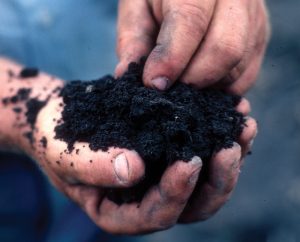
All soil textures have advantages and disadvantages, depending on climate, topography, and crop. The soil texture of large areas, like fields, can’t really be modified to suit a particular crop, so a crop must be chosen that does well in the available soil. For example, if you have a field with sandy soils you aren’t going to truck in tons of clay and silt to make the soil suitable for corn. Instead, you’ll grow a crop like potato that does reasonably well on a lighter, sandy soil. For crops grown in greenhouses or containers, however, you can choose the soil texture to suit the crop you want to grow.
Review questions
- What are the three particles that make up soil texture?
- Which is smallest? Largest?
- Is a loam soil high or low in clay relative to the other particles?
- How do you determine soil texture using a soil jar?
Soil structure
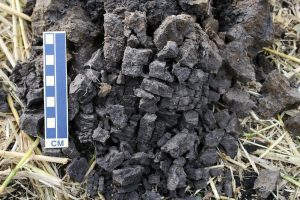
Soil structure refers to the way in which the soil particles and other materials like the organic matter in the soil bind together into clumps. These clumps are called aggregates. Pure sand does not clump together into aggregates at all (think about how hard it is to get sand at a beach to stick together for a sand castle). When sand, silt, clay, and organic matter interact to form small aggregates, like the ones shown below, they create what is called a granular structure. Large holes in the aggregates provide spaces for gasses and water to pass through, while smaller holes hold water. The need for water is obvious, but the need for gas exchange may not be. As you know, root cells are growing, which means they require oxygen and give off carbon dioxide as a waste product. Oxygen needs to be available in the root zone, and carbon dioxide needs to be vented. If soils are waterlogged, plants die because too much carbon dioxide builds up around the roots and the roots are starved of oxygen. It is therefore important for soils to have these holes in the aggregates for gas exchange. This is called the aeration-porosity of the soil. Organic matter, which in this case refers to decaying bits of formerly living material, helps build the aggregates by gently sticking the soil particles together. The space between and within aggregates provides aeration-porosity.
The illustration below includes a cross section of soil, showing several soil aggregates packed together. Each aggregate is built from sand, silt, clay, and organic matter (also called humus). Note the micro- and macropores for water and gas exchange.
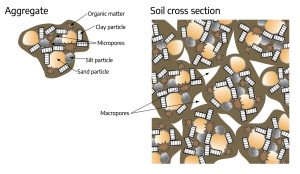
Soil with granular aggregation that favors plant growth by holding water and nutrients, yet allows for drainage and gas exchange, is said to have good tilth. The soil hangs together (unlike sand), doesn’t form hard clumps (unlike clay), and breaks apart into crumbly moist chunks when you turn over a spade of earth. While gardeners are usually stuck with whatever soil texture they might have in their gardens., one of the most important and readily accomplished tasks a gardener can take on to improve garden soil is to improve the soil structure by:
- increasing the soil organic matter, and
- reducing soil compaction.
Increasing soil organic matter will improve and stabilize soil aggregation. Reducing compaction, like foot traffic through the garden, will maintain the macro-and micropores in the soil to promote drainage, moisture retention, and gas exchange.
Watch this video to take a close look at a sandy soil (2:41)
Review questions
- What makes up the glue that holds the soil particles into aggregates?
- Why is gas exchange in soils important for plant growth?
Soil organic matter
Soil organic matter refers to carbon-based material in the soil that was originally a living organism, whether plant, animal, or microbe. Sometimes, soil organic matter also refers to organisms such as bacteria, fungi, insects, and worms that are still living in the soil, but this discussion refers to the materials that were once alive and are now dead and decomposing. Leaves, stems, and roots eventually die, are incorporated into the soil, and decompose. Soil organisms decompose the former living material and transform it into material called humus. Humus is sticky, and helps bind soil particles together into aggregates, as noted above. Humus also can absorb and hold up to six times its weight in water, so it is very important in improving light (sandy) soils. The decomposing organic matter also releases nitrogen and other nutrients that the plant can take up for growth. And finally, humus, like clay, holds nutrients in the soil through electrochemical charge; organic matter is negatively charged, so it holds positively charged cations like calcium that are important for plant growth.
In summary, organic matter is formerly living matter that is transformed in the soil into humus. Humus helps stick soil particles together to improve soil structure, holds water in droughty soils, and holds plant nutrients. Decomposing organic matter makes nutrients such as nitrogen available to plants.
Organic matter is added to soils in several forms:
Compost
For gardeners, this may be the most familiar form of organic matter. Leaves, weeds, grass clippings, and other organic material are mixed together and occasionally turned to promote decomposition. This results in humus that, when added to the soil, builds soil structure. Most of the nutrients have been used by the organisms that are decomposing the organic matter, are lost to the air, or are leached away by rain, so compost isn’t very effective as a nutrient source. Its main purpose is to build soil structure and assist in retaining available moisture and nutrients.
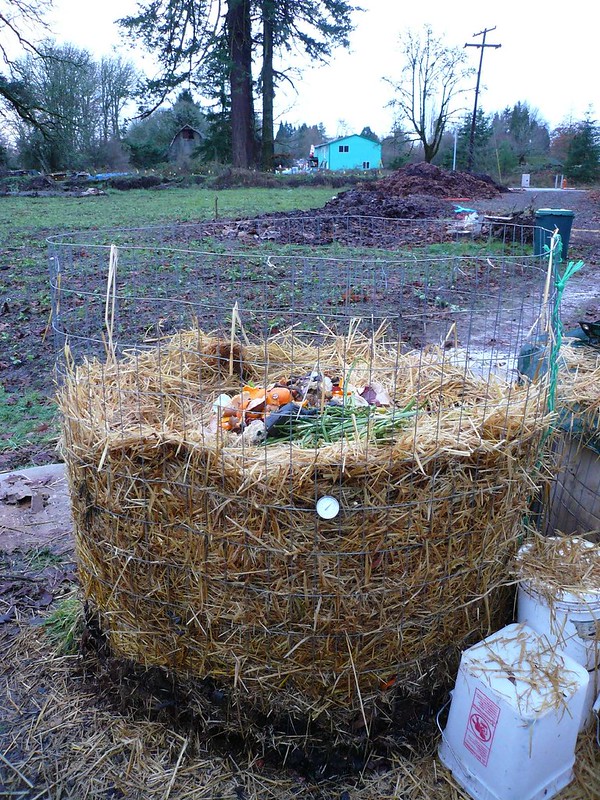
Green manure, or cover cropping
A crop grown with the sole purpose of tilling the crop into the land to increase the organic matter is called green manure. Green manure crops are used to change soil structure by incorporating organic matter directly into the soil. This technique is also used extensively in horticultural crop production to reduce soil-borne pathogens, and these crops serve a very useful purpose of smothering weeds.
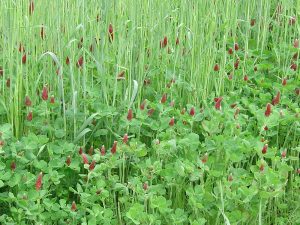
Incorporating crop residues
After a crop is harvested, it is good agricultural and horticultural practice to incorporate the remaining plant material into the soil. Sometimes this is done with a moldboard plow to completely bury the residue, but the more modern method is to use the bare minimum of tillage, or to leave the residue on the top of the soil and plant over the dead material the next spring. The latter method, called no-till, is particularly useful for minimizing soil erosion caused by soil particles blowing away with the wind or moving with flowing water.
The addition of too much organic matter that has too much carbon and not enough nitrogen can deplete the soil of nitrogen and harm plant growth. For instance, if you try to improve the organic matter of your soil by tilling in bales of straw or sawdust (both of which are almost all cellulose, which is very high in carbon), when the microbes begin to break the straw down they need to absorb nitrogen from the soil just for their own growth. If instead you add manure to the soil, which is a blend of straw (high carbon) and animal waste (high nitrogen), the microbes can use the nitrogen from the manure for their own growth as they decompose the organic matter and make more nitrogen available to plants.
Review questions
- Why add organic matter to the soil?
- Is all organic matter of the same value when added to soil, or are some types of organic matter better than others? Why?
Containers and raised beds
Garden soil cannot be used for container gardens, sa it compacts too tightly in pots and has terrible drainage. Instead, it is best to a soil-less mix like those available at nurseries, or to make a mix that is high in an organic matter like peat moss or rice hulls, to increase aeration porosity.
Watch this video to take a close look at a soilless container growing medium (0:58)

Author Dr. Tom Michaels developed this salad table, above, which has great potential for use in urban areas with smaller areas for growing greens, including apartment patios. This table is made with 2×4 lumber for the sides and legs, with hardware cloth and landscape fabric for the bottom of the table. The growth medium is normally a peat-based potting mix. A table this size supplies enough salad greens throughout the summer for two adults. You could modify it to have deeper soil so that you can raise a tomato or pepper plant.

Since the growing medium is potting mix, it dries out quickly. You can see a few modifications in this Hydroponic Salad Table, also created by Dr. Michaels. It’s about 2′ x 4′ x 7.5″ deep and made with lumber, a plastic liner, and a styrofoam lid. About 30 gallons of nutrient solution is added to the box, the box is covered with a lid, and salad green seedlings like lettuce, spinach, chard, and kale are placed in holes in the lid. The plants yield greens for most of the summer and little or no water needs to be added.
To see more about the hydroponic salad table, see the Hydroponic Salad Table website, where Dr. Micheals has posted more information about how you can make a table like this.
You might find that salad tables, container gardens, or raised beds can keep you in touch with the food you eat while you retain your urban lifestyle.
The big three on fertilizer bags
Fertilizer bags and containers display a series of three numbers separated by dashes. This is called the fertilizer’s analysis. The numbers represent the percentage of the fertilizer that is nitrogen (N), phosphorus (P), and potassium (K) — always in that order. N, P, and K are the elements needed by plants in the greatest quantities. Nitrogen is a key element found in protein, phosphorus is an important component in energy transfer molecules like ATP and as part of the DNA backbone, and potassium is an essential part of the mechanism for moving nutrients into and out of cells. Other elements can also be important in small quantities and in special circumstances, but N, P, and K are the most common plant nutrients.
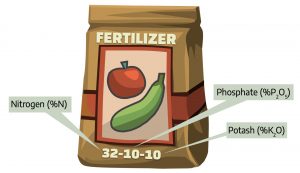
A 10-10-10 general purpose garden fertilizer has 10% nitrogen, 10% phosphorus, and 10% potassium. The rest is filler, like sand or fine gravel. In Minnesota, fertilizers available to homeowners typically have no phosphorus because of legislation aimed at reducing phosphorus runoff into our lakes. Phosphorus is considered to be the limiting factor in algae growth, so if phosphorus runs off yards and gardens into lakes it causes algae blooms. In addition, our garden soils normally have sufficient phosphorus. A general fertilizer analysis without phosphorus would be 10-0-10. Nitrogen is usually the nutrient most limiting for plant growth, so it is worth it to read through the labels.
A caution: seeking the best value per pound of N isn’t always the right strategy. Sometimes the form of the nutrient is important. If you are interested in growing a hydroponic salad table, the plants need a particular form of nitrogen called nitrate, which is not usually found in big, cheap bags of fertilizer; it’s more likely to be found at a hydroponic shop, and costs more per pound of N than other forms.
Review question
- Is a 20-pound bag of 10-0-0 fertilizer that costs $10 a better value than a 10-pound bag of 46-0-0 that costs $20? Why or why not?
Relative proportion of sand, silt, and clay particles in the soil.
Largest particle in soil and helps increase aeration.
Intermediate particle size in soil.
Smallest particle in soil and has high nutrient holding capacity.
The way in which the soil particles and other materials, like the organic matter in the soil, bind together into clumps.
Material that has come from a recently living organism (such as plants) that may be partially or fully decomposed.
"Clumps" in the soil; see soil structure definition.
Sticky material made from organic matter that helps bind soil particles together into aggregates; it can absorb and hold up to 6x its weight in water, it releases nitrogen, and holds positively charged cations for plant growth.
Interaction of small soil aggregates; it is important to have a mixture of large and small holes between the aggregates to allow for water and gas exchange.
Carbon-based plant, animal, and/or microbe tissues that are in the process of breaking down; increasing soil organic matter improves and stabilizes soil aggregation.
When the pore spaces between soil aggregates are compressed.
One of the most important elements for plant growth (by quantity); it is a key element found in protein; abbreviated N.
A type of organic matter that builds soil structure and assists in retaining moisture and nutrients.
Crop grown to purposefully be tilled back into the soil to increase the organic matter (and thus change the soil structure). They can also smother weeds.
Process of incorporating the residue from the top of the soil into the soil; there are many types of tillage.
One of the most important elements for plant growth (by quantity); it is a key component in energy transfer molecules like ATP and as part of the DNA backbone; abbreviated P.
One of the most important elements for plant growth (by quantity); it is a key part of the mechanism for moving nutrients into and out of cells; abbreviated K.
N-P-K content of a bag of fertilizer; it is shown in percentages by weight.

